mobile View, to the German Version tap the flag
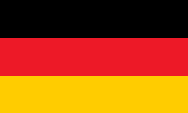

- Republic of Finland
- parliamentary republic
- own names: Suomen Tasavalta (Finnish), Republiken Finland (Swedish)
• Flags
• Historical Flags
• Meaning/Origin of the Flag
• Coat of Arms
• Meaning/Origin of the Coat of Arms
• Aircraft Roundel
• Regional Flags
– Åland Islands
• Map
• Numbers and Facts
• History
• Origin of the Country's Name
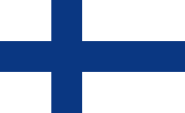
National and merchant flag,
ratio = 11:18,
Source, by: Wikipedia (D)





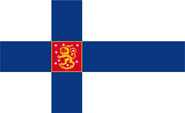
State flag,
ratio = 11:18,
Source, by: Wikipedia (D)



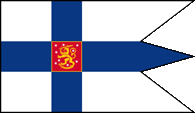
Naval flag,
ratio = 11:19,
Source, by:
Wikipedia (D)



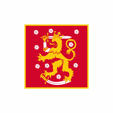
Naval jack,
ratio = 1:1,
Source, by: FOTW



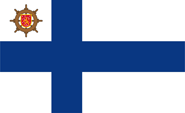
1.) Differentiational flag for pilot's vessels,
2.) Flag of the Merchant Shipping Bureau,
ratio = 11:18,
Source, by: Die Welt im bunten Flaggenbild




Flag of the President,
ratio = 11:19,
Source, by: Wikipedia (D)



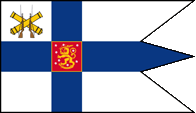
Flag of the Minister of Defense,
ratio = 11:19,
Source, by: FOTW



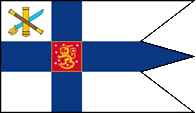
Flag of the Commander of the Defence Forces,
ratio = 11:19,
Source, by: FOTW



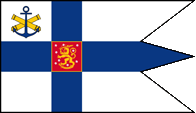
Flag of the Commander of the Navy,
ratio = 11:19,
Source, by: FOTW




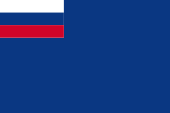
1809-1821,
Merchant flag,
Source, by:
FOTW



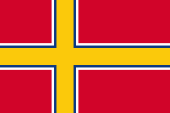
December 1917 – May 1918,
Merchant flag,
Source, by:
FOTW



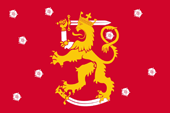
December 1917 – May 1918,
State flag,
Source, by:
FOTW




The Finnish flag shows on white ground a blue Scandinavian Cross, what means a cross which is to the pole-site. All Scandinavian countries use as a sign for relationship and togetherness such a cross in their flags. It is called by the Finns "Siniristilippu" what means "Blue Cross Flag". The flag was introduced by law on the 29th of May in 1918 (other sources mean the 12th of February in 1920). On 26th of May in 1978 some changes had been established by law for the last time. The colours, are given for the flag: blue = pt 294, red = pt 186, yellow = pt 123. About the origin of the flag, there are different statements. It was created in the second half of the 19th century. As the creators of the flag on one hand are called the artists Eero Snellman and Bruno Tuukkanen, but then - on the other hand - the poet Sakari Topelius, who has submitted a draft in 1862, and declared in 1870 that the colors symbolize the snow and the lakes of Finland. The proportions of the flag are to calculate as follows (Thanks to Heikki Kauppi): length: 18 = white 5 + blue 3 + white 10, height 11: = white: 4 + blue 3 + white 4.
Source:
Flaggen Wappen Hymnen,
Wikipedia (D),
Die Welt der Flaggen,
Alle Flaggen alle Staaten


Coat of arms of Finland,
Source, by:
Corel Draw 4

The finnish coat of arms appears in all official flags and even on the the naval jack. The momentary flag from 1918 was even a scutcheon-flag. The lion scutcheon goes back to the tomb of the Swedish king Gustav I. from
the house and dynasty of Wasa (*1496–†1560). The in this way Swedish heraldry comes from this fact, that Finland between 1249 and 1809 belonged to Sweden. The scattered nine silvery roses on the red blazon stand for the nine historical provinces of the country.
Source:
Flaggen Wappen Hymnen


since 1945,
Aircraft Roundel,
Source, by: Wikipedia (EN)

1918–1945,
Aircraft Roundel,
Source, by: Wikipedia (EN)

Location:
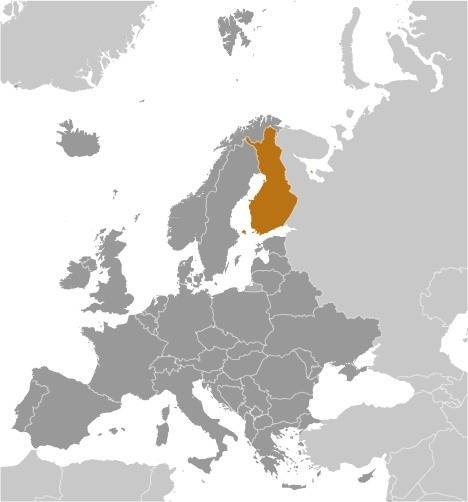
Source: CIA World Factbook
Map of the country:
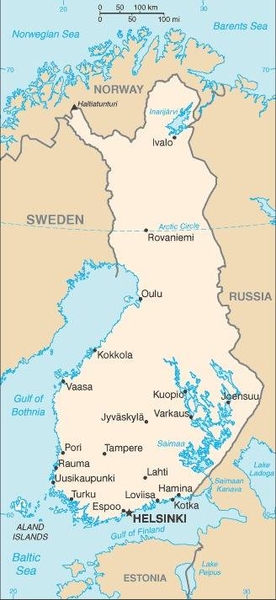
Source: CIA World Factbook

Area: 130.681 square miles
Inhabitants: 5.536.146 (2020), thereof 88% Finns, 5% Swedes, 1% Russians, 0,13% Sami (Lapps), even ca. 3500 Germans
Religions: 68% Protestant, 1% Orthodox, 0,15% Roman Catholic
Density of Population: 42 inh./sq.mi.
Capital: Helsinki (Helsingfors), 648.042 inh. (2018)
official Languages: Finnish, Swedish
other Languages: Sami (Lappic), Russian
Currency: 1 Euro (€) = 100 Cent
Time Zone: GMT + 2 h
Source:
Wikipedia (D),
Deutsche im Ausland

2nd century · immigration of the Finns in the initial Swedish-Russian settlement area
1249 · crusade of the Swedes against the Finns
1323 · treaty of Paehkinaesaari: Finland becomes officially a part of Sweden, many Swedes immigrate
1714–1721 · Nordic War, Finland is occupied by the Russians
1721 · Sweden cedes Ingermanland (South East Finnland), Estland, Livland and parts of Karelia (East Finnland) to Russia
1809 · treaty of Fredrikhamn: Sweden cedes Finland to Russia, Finland becomes a grand principality with a relative big autonomy
1812 · Helsinki becomes capital
1863 · Finnish becomes official language beside Swedish
1865 · the Great Principality of Finland introduces his own currency
1899 · strengthen russification
1900 · introduction of Russian as official language
1901 · dissolution of the Finnish army by Russia
1905 · successful anti-Russian general strike, concessions to the Finns
1906 · parliamentary reform
6th of December in 1917 · Lenin's coup d'état in Russia enables Finland the declaration of independence
1918 · victorious civil war of the government against bolshevistic gangs
1919 · Finland becomes a republic
1920 · treaty of Dorpat: the Soviet Union recognizes Finland's borders
1921 · London conference: the Aaland Islands come to Finland
1930 · the "farmer's march" (Lappo Movement) coerces the political disconnection of the communists
1939 · invasion of the Soviet Army, powerful Finnish resistance
1940 · treaty of Moscow: Finland loses 10% of his territory to the Soviet Union
1941 · Finnish troops attack the Soviet Union for re-purchase of the lost territories
1944 · invasion Soviet Army, armistice
1947 · peace of Paris: acceptance of the frontier of 1940 by Finland
1948 · "friendship treaty" with the Soviet Union
1989 · the Soviet Union recognizes the neutrality of Finland
Source:
Atlas zur Geschichte,
Wikipedia (D),
World Statesmen,
RetroBib Retrobibliothek,
Discovery '97,
Weltgeschichte

The name of the country as "Finland" can be literally translated as "Wetlands", because this term goes back to the Old High German word for "swamp" what "fenni" means. But the Finns themselves call their country "Suomi", which goes back to the proper name of the Finns "Suomalaiset". The origin of this name is not known, but has probably something to do with the "Sami" (Lapps) in northern Scandinavia.
Source:
Atlas der wahren Namen,
Wikipedia (D)


![]()











































